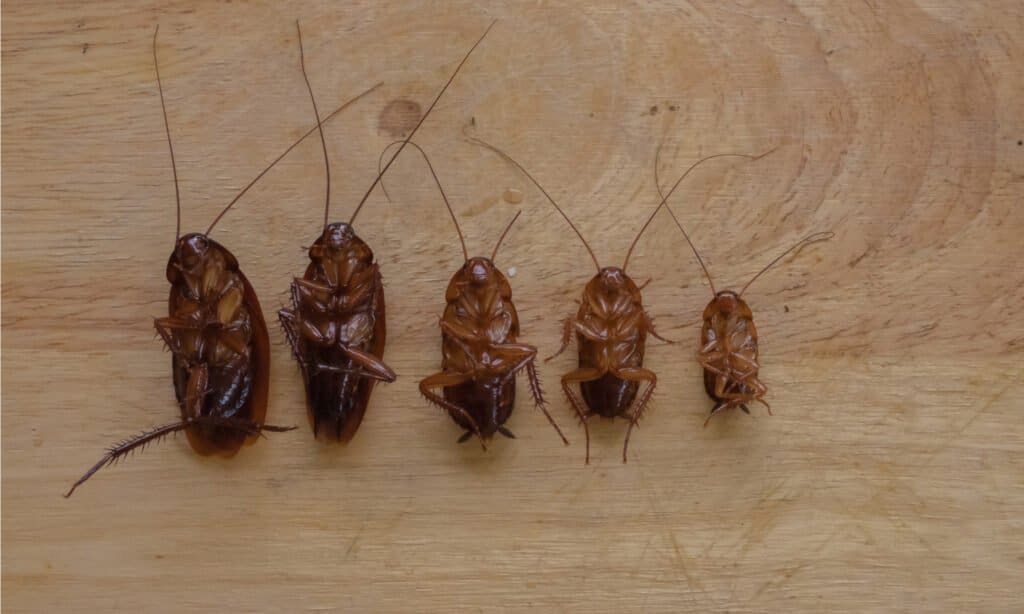Florida Woods Cockroach
Eurycotis floridana
Often found on palmetto trees
Advertisement
Florida Woods Cockroach Scientific Classification
- Kingdom
- Animalia
- Phylum
- Arthropoda
- Class
- Insecta
- Order
- Blattodea
- Family
- Ectobiidae
- Genus
- Blattella
- Scientific Name
- Eurycotis floridana
Read our Complete Guide to Classification of Animals.
Florida Woods Cockroach Conservation Status
Florida Woods Cockroach Facts
- Prey
- Decaying plant and animal matter
- Name Of Young
- Nymph
- Group Behavior
- Colony
- Fun Fact
- Often found on palmetto trees
- Biggest Threat
- Extermination by humans
- Most Distinctive Feature
- Flattened, egg shaped body
- Other Name(s)
- Palmetto bug, Florida stinkroach, skunkroach
- Gestation Period
- 48 days
- Litter Size
- 12-24 eggs per egg case
- Diet
- Omnivore
- Type
- Insect
- Common Name
- Palmetto bug
- Number Of Species
- 1
- Location
- North America
- Group
- Cockroach
View all of the Florida Woods Cockroach images!
“The Florida woods cockroach is commonly known as the palmetto bug in the southeastern United States.”
You may read the word ‘cockroach’ and think immediately of those pesky crawlers that invade homes and spread filth wherever they go. But, rest assured, the Florida woods cockroach is not one of those roaches. Actually, startlingly few species of cockroach ever cause problems for humans. Out of nearly 5,000 species worldwide, only a handful ever come into contact with humans.
Of those few species, the Florida woods roach is one that is commonly found in the hot southeastern states of Florida and Georgia. Known widely as a ‘palmetto bug’ because of its partiality for palmetto plants, the Florida roach makes its home mainly outdoors. Occasionally, they may wander indoors in search of food or shelter, but they would much rather be outside in the dirt, or hanging out on a nice plant.
4 Incredible Florida Woods Cockroach Facts!
- Florida woods cockroaches are also known as palmetto bugs
- Both females and males lack wings
- Florida roaches can grow up to 1.5 inches long
- Nymphs molt seven times before adulthood
Florida Woods Cockroach Species, Types, and Scientific Name
The scientific name of the Florida woods cockroach is ‘Eurycotis floridana.’ They’re commonly called palmetto bugs, Florida stinkroaches, or skunk roaches. Florida roaches are native to the extreme southeastern part of the United States; they can be found in the Florida Keys, Florida, and the southern parts of Georgia, Alabama, and Mississippi.
Appearance: How to Identify Florida Woods Cockroaches
Palmetto bugs tend to be very thick-looking roaches. They don’t have the long, skinny shape of the American cockroach, though they’re not quite as big as the giant Madagascar hissing roach. More than anything, they resemble dark brown, flattened eggs.
Like all roaches, Florida woods cockroaches have two antennae and six legs. Their antennae are nearly the length of the body and extend out in front of the head, rather than curling back over the body. There are three legs on each side of the body; the pair closest to the head are the shortest, while those at the rear are the longest. Each leg comes equipped with fierce-looking spikes—but don’t worry, they’re for climbing, not attack.

©Nainong/Shutterstock.com
Do Florida Woods Cockroaches Fly?
Some species of roach have wings and can fly, but not the palmetto bug. Florida woods roaches are wingless. Instead of wings, they have hard, shield-like structures on their backs called ‘tegmina.’ The tegmina are located just behind the pronotum—the hard shield that protects the back of the roach’s head.
Like other species of roach, the Florida woods cockroach has very simple mouthparts. In fact, these mouthparts have remained extremely simplified for hundreds of millions of years. In cockroaches, the mouthparts actually face backward due to the orientation of the head on the body. If human heads were attached the same way roach heads are attached, our faces would point up to the sky.
Life Cycle: How to Identify Florida Woods Cockroach Eggs
All cockroaches share three life stages: egg, nymph, and adult. For the Florida woods roach, the egg phase takes about 48 days, depending on weather conditions. Female roaches produce eggs encased in an egg case that becomes hard soon after birth. Once she’s expelled the egg case, the female glues it in a safe place, like inside a dead log, or under thick substrate.
Upon hatching, the nymphs are bright white and soft. Over time their exoskeletons thicken and darken; they shed them 6-8 times before reaching adulthood. After 100-120 days, the nymphs reach full maturity and no longer shed their exoskeletons—they’re done growing.
As adults, palmetto bugs can reach 1.5 inches long and 1 inch wide, and live for up to two years. In that time, females can reproduce with or without males—though unfertilized eggs are unlikely to hatch, and nymphs born of the unfertilized eggs rarely reach adulthood.
Habitat: Where to Find Florida Woods Cockroach
Florida woods roaches aren’t likely to invade your home. If you’re dealing with an infestation of indoor roaches, chances are very good that they’re not Florida woods roaches. It’s not impossible to find them inside, particularly if there are easy means of access, like open doors, but palmetto bugs much prefer the outside.
Further, Florida woods cockroaches don’t live anywhere cold, and they’re largely confined to the temperate regions of the southeastern United States. So, if you’re living in Asia, South America, or anywhere else outside the southern United States, it’s unlikely that you’ll see a palmetto bug.
Diet: What do Florida Woods Cockroaches Eat?
Palmetto bugs are scavengers; they’re detritivorous omnivores. Their main source of food comes from rotting plant matter, like leaves, bark, fruit, and wood. This diet is part of the reason you won’t generally find Florida woods roaches indoors—human homes don’t tend to have large amounts of decaying plant matter. You’re much more likely to see a palmetto bug outside in a planter bed or potted plant than in a home or business.
What Eats the Florida Woods Cockroach?
As a slow-moving, ground-dwelling insect, the Florida woods roach is vulnerable to attack from many creatures. These include small mammals like mice and rats, frogs, lizards, birds, and even small snakes. However, the palmetto bug has a unique defense capability; stinky chemical secretions.
When in danger, the Florida woods roach sprays an oily, nasty-smelling liquid from its rear end. The liquid is harsh enough to irritate the eyes and skin of any creature it comes in contact with, including humans. So, if you see a palmetto bug and feel like you just have to pick it up—don’t, or risk getting sprayed with noxious chemicals.
Florida Woods Cockroach vs. Oriental Cockroach
There is one type of problem roach that looks very similar to the Florida woods roach: the Oriental cockroach.
Oriental cockroaches are so dark brown that they’re almost black. Like palmetto bugs, they have ovoid bodies and almost lack wings. But, they have much longer antennae than the Florida woods roach. Instead of fleshy pads where the wings should be (as in the Florida woods roach), the Oriental cockroach has tiny, vestigial wings.
If you’re still not sure which type of cockroach you’re looking at, consider where you found it. If it was inside, then it’s probably an Oriental roach. Further, Florida woods roaches move much slower than Oriental roaches.
Prevention and Extermination: How to Get Rid of Florida Woods Cockroaches
If you fear you may have too many palmetto bugs hanging around your home, there are a few steps you can take. Your first step should be to clear away all leaf litter and green waste. Doing so will remove the roaches’ main food source, and they should quickly move on.
If that doesn’t do the trick, you may want to consider using store-bought roach traps and pesticides, like borax. Remember, if your roach problem is indoors, you’re probably dealing with a different species. If the problem persists, consider calling in a professional pest exterminator.
View all 91 animals that start with FThank you for reading! Have some feedback for us? Contact the AZ Animals editorial team.
Sources
- University of Florida Entomology Department, Available here: https://entnemdept.ufl.edu/creatures/urban/roaches/florida_woods_cockroach.htm

















